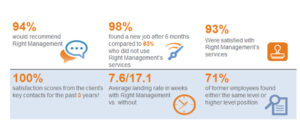Right Management Great Lakes recognizes an escalating workforce crisis in U.S. healthcare, dramatically worsened by the Covid 19 pandemic.
The U.S. Surgeon General recently issued a stark warning about labor shortages, high turnover rates, and mental health issues among providers, exacerbating this crisis enormously. “The nation’s health depends on the well-being of our health workforce. Confronting the long-standing drivers of burnout among our health workers must be a top national priority,” declared U.S. Surgeon General Vivek Murthy.
Human resource leaders in healthcare must actively grapple with enormous challenges, today and for the near future. Just look at healthcare employee well-being statistics from 2022 surveys:
- 40% of health care workers indicate they feel anxiety or dread about going to work.
- 50% said they are either at their breaking point or looking for a new job due to stress and trauma they have endured while working in healthcare.
- 80% of nationwide healthcare workers have experienced workplace violence during the Covid 19 crisis.
- Almost 25% of healthcare workers felt bullied, threatened, or harassed at work within the last two years.
And the healthcare labor shortage is at crisis proportions:
- 500,000 registered nurses are forecasted to retire by the beginning 2023, yet U.S. Bureau of Labor statistics projects the need for 1.1 million new registered nurses by 2027.
- There will be a 3-million-person shortage of lower-wage health workers (nursing assistants, medical assistants, home health aides) by 2027.
- In mental health, alone, (a critical area of concern for both other health care providers who may need ongoing treatment, and the general population), there is a projected shortage of half a million skilled workers by 2027.
- By 2030, the Association of American Medical Colleges forecasts a nationwide shortage of up to 139,000 physician positions unfilled with the largest gaps in primary care.
There is a COST to all of this:
- Nationwide annual burnout-related turnover costs are $9 billion for nurses
- Nationwide annual burnout-related turnover estimates range from $2.6 billion to $6.3 billion for physicians.
What can a healthcare human resource leader do? With Right Management Great Lakes help, there are both interim and long-term solutions. We help you address issues, pragmatically and empathetically. Protection of the health and safety of all employees is paramount. A well-developed, and employee-friendly, plan that includes competitive wages, benefits, family leave, fair workload evaluations, ongoing paid training, and family-oriented policies is just the beginning.
Offering humane outplacement programs when needed, from Day 1, (particularly when reorganization is necessary) is key to becoming an employer of choice in a highly competitive marketplace. Ensuring adequate skilled staffing, through adept assessment and recruitment, as well as providing ample protective gear is vital. Investing in technology systems that lessen administrative paperwork and assist health workers to conserve time for one-to-one patient care is paramount. Prioritizing social connections, and community, as a core value of the health system’s mission-driven and well-communicated culture is also essential.
Ongoing leadership coaching, employee and leader assessments, disciplined workforce planning, including process-oriented onboarding and offboarding, can all aid HR leaders address the talent crises, assist leaders and employees to evolve, and develop healthy future plans.
For over 4 decades, Right Management has worked with large healthcare systems as they have grown, consolidated, and evolved. We can do the same, today, in this time of crisis. Please contact us.





